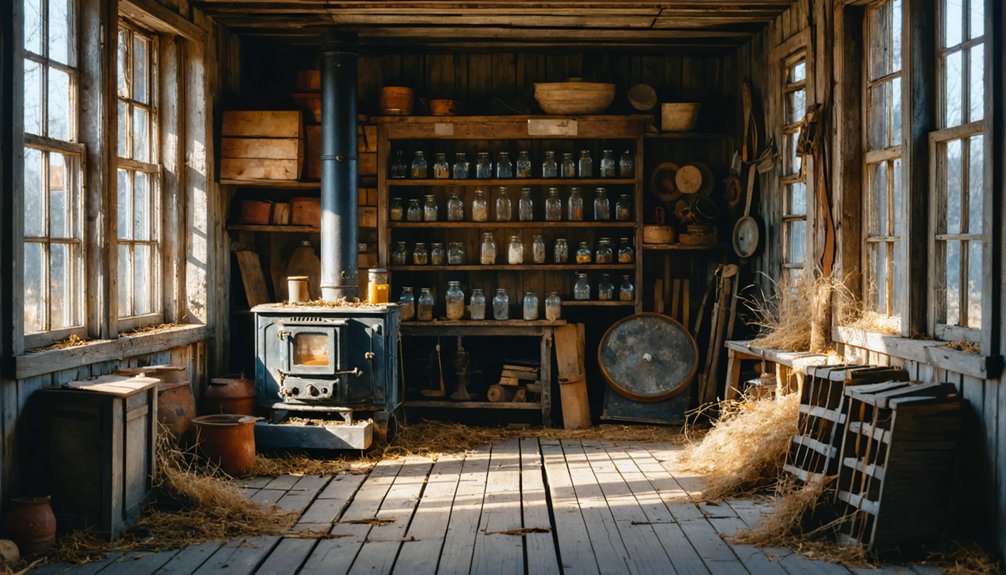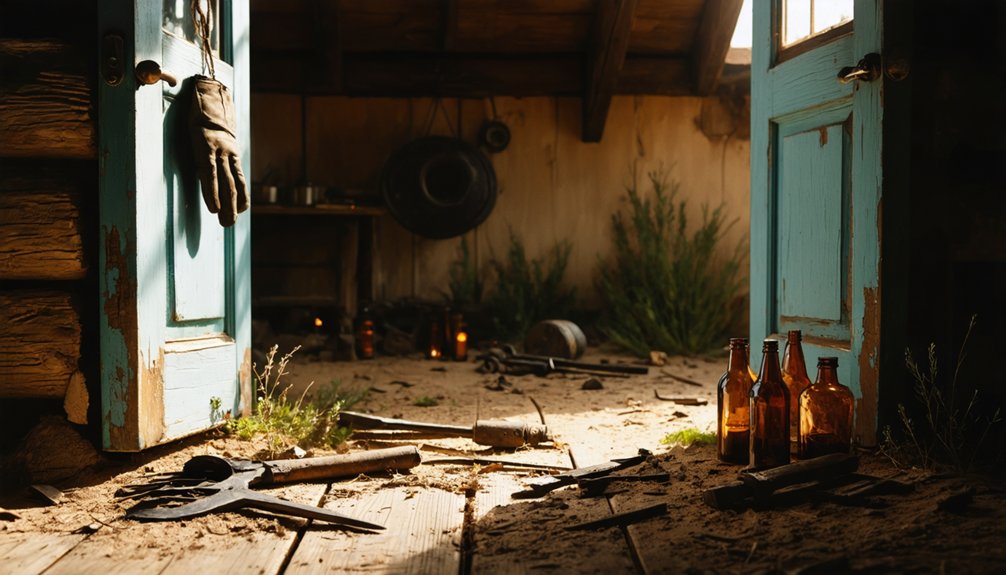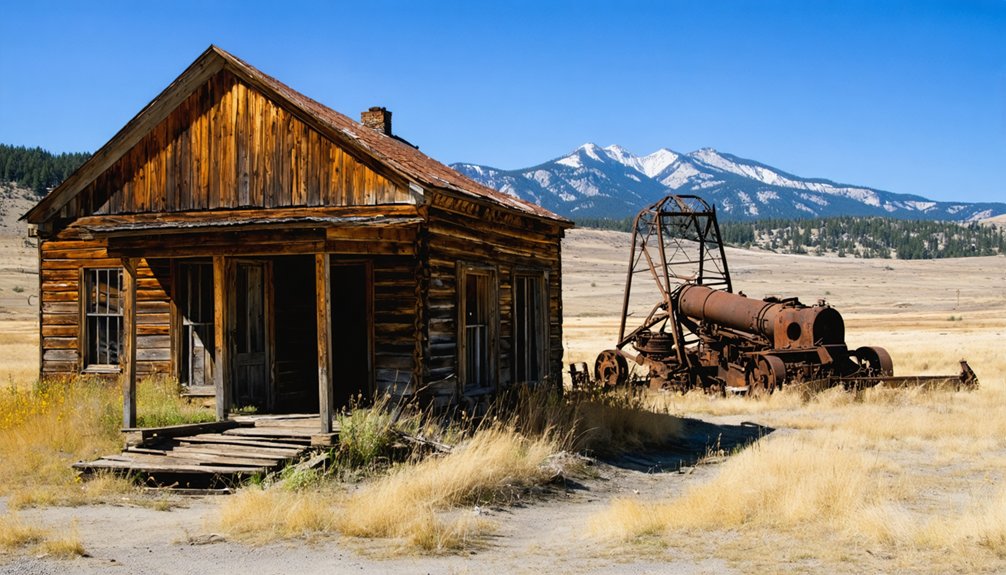You’ll find Copper Camp nestled in South Dakota’s Black Hills, where it emerged as a mining settlement in the mid-1870s. The camp thrived on copper and precious metal extraction, with over 370 miles of tunnels and temperatures reaching 130°F underground. Workers lived in modest wooden homes and canvas tents, relying on communal facilities and preserved foods. Though harsh conditions and dwindling resources eventually led to its abandonment, the site’s mining legacy holds countless frontier stories.
Key Takeaways
- Copper Camp emerged in the mid-1870s during the Black Hills gold rush, primarily focused on copper mining and precious metal extraction.
- The settlement featured essential infrastructure including boarding houses, blacksmith shops, and wooden homes for the mining community.
- Miners endured harsh conditions with temperatures exceeding 130°F in tunnels, while living in basic accommodations with limited amenities.
- Economic decline occurred due to diminishing mineral yields and rising operational costs, leading to widespread abandonment by workers.
- The ghost town’s legacy remains significant in South Dakota’s mining history, having contributed to the state’s development as a mining hub.
The Rise of a Black Hills Mining Settlement
When gold and other precious metals were discovered in the Black Hills during the mid-1870s, Copper Camp emerged as one of the region’s many mineral-driven settlements.
The Black Hills’ mineral wealth gave rise to settlements like Copper Camp, a testament to America’s pioneering mining spirit.
You’ll find this camp’s origins deeply rooted in the rush for mineral-rich fissure veins that grew more valuable with depth. Cultural influences from mining legends shaped the development of essential infrastructure, as companies like the Golden Return Mining Company claimed roughly 100 acres of prime territory. Like other successful mining operations in the United States, the camp utilized froth flotation methods to improve mineral recovery rates.
You’ll discover how the camp rapidly expanded with the construction of boarding houses, blacksmith shops, and stables that could house dozens of horses. Colonel James Clark established himself as a prominent local figure after arriving in 1895.
The settlement’s prosperity relied on both free-milling ores that workers processed through stamp mills and refractory ores requiring more complex smelting operations.
Life in the Copper Mining Community
You’d find daily life in Copper Camp centered around the rigorous mining operations, where workers endured long shifts underground extracting copper ore using basic machinery and manual labor.
The camp’s modest wooden homes and shanties, clustered near mine entrances, offered minimal comfort with wood stoves for heat and cooking, while residents shared communal outhouses and hauled water from local wells. Like the nearby town of Deadwood that produced 25 million ounces of gold, Copper Camp hoped to strike it rich through mineral extraction. Some miners worked in vertical shaft mines, following the underground veins of ore deep into the earth.
Despite the harsh conditions, the community came together for social gatherings, hosting occasional dances, picnics, and welcoming traveling shows that brought entertainment to this remote Black Hills settlement.
Daily Mining Operations
Life in the copper mining community centered around grueling underground work, where miners endured temperatures exceeding 130 degrees Fahrenheit at depths reaching 7,000 feet.
The mine’s operation at 4,902 feet elevation required specialized equipment and techniques for high-altitude mining.
Miners prioritized safety through the use of protective gear including helmets, work lamps, and steel-toed shoes.
You’d find yourself traversing complex tunnel systems stretching over 370 miles, following strict mining schedules that kept the operation running day and night.
Safety protocols evolved as miners faced constant threats from fires and environmental hazards.
You’d rely on compressed air locomotives to transport ore through the extensive network of shafts and winzes.
Specialized roles divided the workforce – from drilling and blasting crews to engineers managing ventilation systems.
The introduction of cyanidization techniques in the early 1900s revolutionized ore processing, boosting gold recovery rates to 94% while stamp mills crushed raw ore day and night.
Community Social Activities
Beyond the intense daily mining operations, Copper Camp’s vibrant social scene brought much-needed relief to hardworking miners and their families. You’d find community gatherings happening regularly in communal halls, where dances, variety shows, and musical performances showcased local talent.
Similar to Black Hills mining towns, these social activities helped create a sense of belonging among residents. Baseball games and boxing matches created friendly competition, while social celebrations like picnics and holiday events strengthened community bonds.
The town’s diverse immigrant population added rich cultural flavors to these gatherings, with Irish, German, Italian, and Eastern European traditions blending at festivals and food-sharing events.
You could catch up on news at the local saloon, attend church services, or join various social clubs. A recreation center built in 1914 provided residents with a library and gathering spaces at no cost.
Mining companies and community groups organized these activities to boost morale and create lasting connections among Copper Camp’s hardworking residents.
Housing and Living Conditions
While miners toiled underground during Copper Camp’s heyday, their living conditions above ground reflected the harsh realities of frontier life.
You’d find housing types ranging from simple canvas tents to modest wooden cabins, with more substantial homes reserved for mine managers. Living conditions were primitive – you wouldn’t have electricity or modern plumbing, and clean water was scarce.
You’d have relied on basic wells for water and dealt with rudimentary sanitation systems. Daily life centered on the mine’s schedule, with your meals consisting mostly of preserved foods and whatever game you could hunt. Like many boom and bust settlements of the era, survival was a daily challenge.
Disease and injury were constant threats, especially with limited medical care available. Despite these challenges, some families put down roots, building permanent homes and establishing a small but determined community around the mine. The community even established a one-room schoolhouse that served both educational and religious purposes.
Mining Operations and Economic Growth
At Copper Camp, you’ll find the hallmarks of turn-of-the-century mining infrastructure, including compressed air locomotives that replaced animal-powered transport in the early 1900s.
The camp’s ore processing operations incorporated Charles Merrill’s revolutionary cyanidation method, which achieved up to 94% extraction efficiency compared to older mercury amalgamation techniques.
Multiple shafts and winzes enabled miners to access deeper ore bodies, though they faced significant challenges managing extreme underground temperatures that could exceed 130°F.
Mining Equipment and Infrastructure
During the early 1900s, mining operations in South Dakota’s gold mines underwent significant technological advancement, marked by the introduction of compressed air locomotives in the 1920s to replace animal-powered transport.
You’d find mining technology advancements transforming the industry, with Charles Merrill’s cyanidization process boosting gold recovery rates to 94%. Deep shaft extensions featured winzes reaching depths of 4,100 feet by the late 1930s, while historical mining machinery evolved to meet growing demands.
Major infrastructure developments included the Ross and Yates shafts, pushing operations beyond 6,800 feet by 1975.
To combat extreme heat at these depths, extensive air conditioning systems were installed in the 1970s. The sophisticated lift and ventilation systems proved essential for maintaining worker safety and operational efficiency in these challenging underground environments.
Ore Processing and Transport
Three major ore processing advancements revolutionized mining operations in South Dakota’s Copper Camp region.
You’ll find evidence of early stamp mills that crushed ore for initial sorting, followed by mercury amalgamation techniques. The game-changing introduction of cyanidization later boosted gold recovery rates to an impressive 94%.
Transport innovations transformed how miners moved ore through the region’s extensive tunnel networks.
You’ll notice the shift from animal power to compressed air locomotives in the early 1900s, markedly improving underground ore haulage efficiency.
Multiple vertical shafts and winzes allowed access to deeper ore bodies, while extensive rail infrastructure connected remote mining camps to processing facilities.
Despite challenges from flooding and fires, these engineering solutions kept ore flowing from mine to mill, supporting the region’s robust mining economy.
Daily Challenges of Frontier Living

Life in Copper Camp tested the limits of human resilience, as settlers faced a relentless barrage of daily hardships.
You’d wake before dawn to gather firewood or coal, knowing harsh winters could trap you indoors for weeks. Every drop of water had to be carefully managed, often hauled from distant springs or unreliable wells.
Resource scarcity shaped your existence. You’d stretch preserved meat and hardtack supplies between irregular deliveries on treacherous roads. Medical care was virtually nonexistent – a minor injury could prove fatal.
You’d spend endless hours performing backbreaking labor in the mines or clearing land, while battling exhaustion and poor nutrition. When night fell, isolation set in. With few neighbors and limited communication, you’d rely entirely on yourself and your closest companions for survival.
The Path to Abandonment
While frontier hardships tested the settlers’ resolve daily, the ultimate challenge that sealed Copper Camp’s fate emerged from its economic foundation.
You can trace the town’s decline through a series of interconnected failures that created a domino effect of economic decay. As copper and precious metal yields diminished, mining operations struggled with rising costs and deteriorating infrastructure. The mining collapse triggered a mass exodus of workers seeking opportunities elsewhere, leading to the shutdown of local businesses and services.
You’ll find that harsh weather and remote location only accelerated the abandonment, as maintaining roads and railways became increasingly difficult.
When the railroad routes shifted and bypassed the town, Copper Camp’s isolation deepened, leaving the remaining residents with little choice but to relocate to more prosperous Black Hills communities.
Exploring the Ghost Town Today

Today, Copper Camp stands as an accessible window into South Dakota’s mining heritage, nestled in the Black Hills near Keystone and Custer.
You’ll find this ghost town just across from Spokane Creek Campground, where a short 15-minute hike leads you to the historic site.
As you explore, you’ll discover three standing buildings, scattered foundations, and vintage cars that tell the story of this abandoned mining community.
Ghost town photography opportunities abound, but visitor etiquette is essential – the structures are fragile and require careful preservation.
You can explore the surrounding forest trails, spot an old miner’s gravestone, and imagine life during the town’s heyday.
For extended visits, you’ll find plenty of boondocking spots along nearby dirt roads, offering scenic views of the Black Hills.
Legacy in South Dakota’s Mining History
As South Dakota’s mining industry flourished in the late 19th century, Copper Camp emerged as one of many essential extraction sites across the Black Hills region.
You’ll find its story woven into a broader tapestry of mineral extraction that shaped the state’s development, alongside famous operations like the Homestake gold mine.
The camp’s cultural impact extended beyond ore production, creating a diverse community of miners, engineers, and tradespeople who contributed to the region’s growth.
While the town helped establish South Dakota as a significant mining hub, you’ll also need to reflect on its environmental consequences.
Like many historic mining sites, Copper Camp’s operations led to lasting changes in the landscape, eventually spurring regulatory reforms as seen at places like the Gilt Edge Superfund site.
Frequently Asked Questions
Are There Any Documented Accidents or Deaths From the Copper Camp Mines?
While 500 deaths occurred in Black Hills mines, you won’t find specific documented accidents at Copper Camp in historical records. Mine safety data from that era primarily focuses on larger operations like Homestake Mine.
What Happened to the Mining Equipment After the Town Was Abandoned?
You’ll find most mining equipment was dismantled and salvaged for value, though transportation limits meant some pieces were abandoned to rust. No historical preservation efforts saved substantial machinery from Copper Camp’s site.
Did Any Original Copper Camp Families Remain in the Black Hills Region?
While you won’t find original families in Copper Camp today, some family descendants carried the copper legacy forward, relocating to thriving Black Hills communities like Deadwood, Hill City, and Custer.
Were There Any Churches or Schools Established During Copper Camp’s Peak?
You won’t find documented church history or school establishment records for this mining camp. Given its short-lived nature, it likely didn’t develop permanent social institutions before declining.
What Native American Tribes Inhabited the Area Before Copper Camp’s Establishment?
You’d find the area’s rich Native Tribes heritage included the Arikara, Cheyenne, and Crow peoples until the 1700s, when the Lakota Sioux arrived and established their sacred cultural dominance.
References
- https://www.sdpb.org/rural-life-and-history/spokane-south-daktoa-black-hills-ghost-town
- https://www.powderhouselodge.com/black-hills-attractions/fun-attractions/ghost-towns-of-western-south-dakota/
- https://www.southdakotamagazine.com/a-ghost-town-called-spokane
- https://en.wikipedia.org/wiki/Carbonate
- https://www.geotab.com/ghost-towns/
- https://www.gorving.com/tips-inspiration/travel-guides/go-rving-these-western-ghost-towns
- https://en.wikipedia.org/wiki/List_of_ghost_towns_in_South_Dakota
- https://www.jstor.org/stable/j.ctt2005tmr
- https://holysmokeresort.com/the-history-of-holy-smoke-camp-resort-in-keystone-south-dakota/
- https://en.wikipedia.org/wiki/Copper_mining_in_the_United_States



